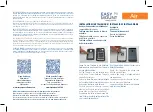
Section 4: Safety Guidelines and Warranty Information
208 4A: Safety
its standards and are used according to the manufacturer’s
recommendations are safe for consumer and industrial use. More
information is available from:
www.fda.gov/cdrh
.
The EPA has, in the past, considered developing federal guidelines for
public exposure to RF radiation. However, EPA activities related to RF
safety and health are presently limited to advisory functions. For
example, the EPA now chairs an Inter-agency Radiofrequency Working
Group, which coordinates RF health-related activities among the various
federal agencies with health or regulatory responsibilities in this area.
OSHA is responsible for protecting workers from exposure to hazardous
chemical and physical agents. In 1971, OSHA issued a protection guide
for exposure of workers to RF radiation [29 CFR 1910.97]. However, this
guide was later ruled to be only advisory and not mandatory. Moreover, it
was based on an earlier RF exposure standard that has now been revised.
At the present time, OSHA uses the IEEE and/or FCC exposure guidelines
for enforcement purposes under OSHA’s “general duty clause” (for more
information see:
http://www.osha-slc.gov/SLTC/radiofrequencyradiation/index.html
).
NIOSH is part of the U.S. Department of Health and Human Services. It
conducts research and investigations into issues related to occupational
exposure to chemical and physical agents. NIOSH has, in the past,
undertaken to develop RF exposure guidelines for workers, but final
guidelines were never adopted by the agency. NIOSH conducts safety-
related RF studies through its Physical Agents Effects Branch in
Cincinnati, Ohio.
The NTIA is an agency of the U.S. Department of Commerce and is
responsible for authorizing Federal Government use of the RF
electromagnetic spectrum. Like the FCC, the NTIA also has NEPA
responsibilities and has considered adopting guidelines for evaluating RF
exposure from U.S. Government transmitters such as radar and military
facilities.
The Department of Defense (DOD) has conducted research on the
biological effects of RF energy for a number of years. This research is now
conducted primarily at the U.S. Air Force Research Laboratory located at
Brooks Air Force Base, Texas. The DOD Web site for RF biological effects
Summary of Contents for SH-P300
Page 1: ...Online User s Guide Single Band PCS Phone Model SH P300 ...
Page 9: ......
Page 11: ...2 ...
Page 13: ...4 ...
Page 14: ...Section 1 5 Getting Started Section 1 Getting Started ...
Page 15: ...6 ...
Page 20: ...Section 2 11 Understanding Your Phone Section 2 Understanding Your Phone ...
Page 21: ...12 ...
Page 81: ...Section 2 Understanding Your Phone 72 2F Managing Call History ...
Page 123: ...Section 2 Understanding Your Phone 114 2H Personal Organizer ...
Page 149: ...Section 2 Understanding Your Phone 140 2J E mail ...
Page 150: ...Section 3 141 Using PCS Service Features Section 3 Using PCS Service Features ...
Page 151: ...142 ...
Page 185: ...Section 3 Using PCS Service Features 176 3B PCS Vision ...
Page 189: ...Section 3 Using PCS Service Features 180 3C PCS Voice Command ...
Page 191: ...182 ...
Page 224: ...215 ...
Page 235: ......
Page 237: ...2 ...
Page 239: ...4 ...
Page 240: ...Sección 1 5 Cómo empezar Sección 1 Cómo empezar ...
Page 241: ...6 ...
Page 246: ...Sección 2 11 Familiarícese con su teléfono Sección 2 Familiarícese con su teléfono ...
Page 247: ...12 ...
Page 307: ...Sección 2 Familiarícese con su teléfono 72 2F Registros de llamadas ...
Page 349: ...Sección 2 Familiarícese con su teléfono 114 2H Organizador personal ...
Page 375: ...Sección 2 Familiarícese con su teléfono 140 2J E mail ...
Page 377: ...142 ...
Page 411: ...Sección 3 Cómo usar las funciones del servicio PCS 176 3B PCS Vision ...
Page 415: ...Sección 3 Cómo usar las funciones del servicio PCS 180 3C PCS Voice Command ...
Page 417: ...182 ...
Page 452: ...Sección 4 Pautas de seguridad e información de garantía 217 4B Garantía limitada al cliente ...
















































